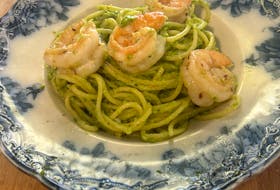Our cookbook of the week is The Food of Sichuan by Fuchsia Dunlop, a James Beard Award-winning specialist in Chinese cuisine. To try a recipe from the book, check out: Mapo tofu , fish-fragrant eggplants and soup noodles with ground pork topping .
Rich tones and revitalizing flavours permeate Fuchsia Dunlop’s The Food of Sichuan (W.W. Norton & Company, 2019). From the deep scarlet tinge of mapo tofu to the characteristic orange-red colour of fish-fragrant eggplants, the regional Chinese cuisine holds the power to simultaneously “restore the body” and “soothe the heart.”
“It’s a really warm, generous and joyful cuisine,” says Dunlop. “It’s so much more than just heat and spice — it’s very varied and subtle.”
Equal parts delicate and fiery, the cuisine of the southwestern Chinese province was little-known in the West when Dunlop wrote the first edition of the book ( Land of Plenty , 2001) nearly two decades ago. The Food of Sichuan , an updated version, contains roughly 70 new recipes — with an emphasis on the classics — and benefits from the vast knowledge she’s gained in the intervening years.
It was in Chengdu, Sichuan’s capital, that she fell in love with Chinese food as a student in 1994. After completing her studies at Sichuan University, she became the first foreigner to enrol in a professional training course at the Sichuan Institute of Higher Cuisine. Now based in London, Dunlop has won four James Beard Awards for her extensive writing on Chinese cooking, a career trajectory she wouldn’t have thought possible in the 1990s.
Her first book proposal was rejected by six publishers, she recalls, “because they all felt that people in the West would not be interested in something as niche as a regional Chinese cookbook.” One of the most profound differences she noticed in revisiting the work was how much awareness there is now of the cuisine. “Sichuanese food has gone from being virtually unknown (abroad) to being hugely popular with people who are interested in food, and Chinese food in particular,” says Dunlop.
Today, with hallmark dishes such as dandan noodles and dry-fried green beans on menus far and wide, novice expectations of Sichuanese cuisine tend to centre on its smouldering use of chilies, and the lip-tingling effects of Sichuan pepper. But as Dunlop impresses, the mala — “numbing-and-hot” — flavour combination, while essential, is just one of 23 “official” complex flavours in the culinary canon.
Take the aforementioned fish-fragrant flavour, “a celebrated Sichuanese invention,” which is one of the region’s most distinctive combinations (and despite its name, contains no fish but rather seasonings that would have traditionally been used in fish dishes). A collection of notes — salty, sour, spicy and sweet — and punchy elements — pickled red chilies, garlic, ginger and green onions — it encapsulates what makes Sichuanese cuisine so special, Dunlop says.
“It shows you the art of balancing and layering many different tastes in a single dish. Fish-fragrance flavour is very complex and it’s supposed to be one of the more difficult ones to do correctly,” she says. “It expresses the character of Sichuanese cuisine in the layering of flavours, and also in the fact that yes, it’s got chilies, but it’s not really that hot.”
While there are dishes, such as the classic Chongqing hotpot, that are intended to be “crazy hot,” Dunlop explains, intense heat is only part of the picture. “That’s not the way most people eat, most of the time. And certainly the cuisine of Chengdu, where I lived, a lot of it is not that hot at all — or it has this element of sweetness with fragrant heat, rather than volcanic heat,” she adds. “A lot of it is a very seductive and gentle kind of spicy cuisine.”
Copyright Postmedia Network Inc., 2020








